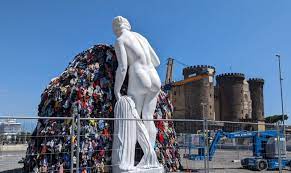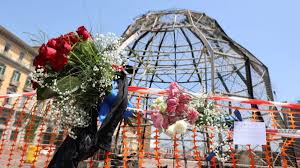

THE VULNERABILITY OF ITALIAN ART WORKS
The recent destruction of a version of an important work of contemporary art, the Venere degli Stracci (Venus of the Rags), the controversial masterpiece of Arte Povera by Michelangelo Pistolesi, which had been set up in Naples main city square, has caused an outcry. The work, which according to the artist represents “the disorder of modern life”, was set deliberately on fire and was reduced to a pile of cinders.
The citizens of Naples have treated the destruction of the installation as a death to be mourned and continue to drape flowers and messages of regret on the empty framework that supported the composition.
Unfortunately, this is only the last in a list of wilful devastation of Italian art and antiquities. Carving initials on the venerable stones of the Colosseum may seem a minor crime in comparison but authorities are worried that it may set off a trend among the 19 thousand + plus tourists who visit the amphitheatre every day.
Unfortunately, monuments and street installations are vulnerable and difficult to safeguard. Some years ago, again in Naples, the Montagna di Sale (Mountain of Salt) by Mimmo Paladino was destroyed during the New Year revels. The artist has subsequently reconstructed his oeuvre in Trapani at the cultural centre of the Foundation Orestiadi at Baglio di Stefano Gibellina (Sicily). The “Capuzzelle” (Skulls) by Rebecca Horn met a similar fate, as did Richard Serra's “Spiral”. And no-one can forget the horrifying incident in 1972 when Australian tourist Laszlo Toth attacked Michelangelo's Pieta with a hammer in a crowded St. Peter's Basilica under the horrified gaze of visitors and custodians. Toth, who was diagnosed as severely disturbed, was interned for a while and then subsequently repatriated.
MSTENHOUSE



